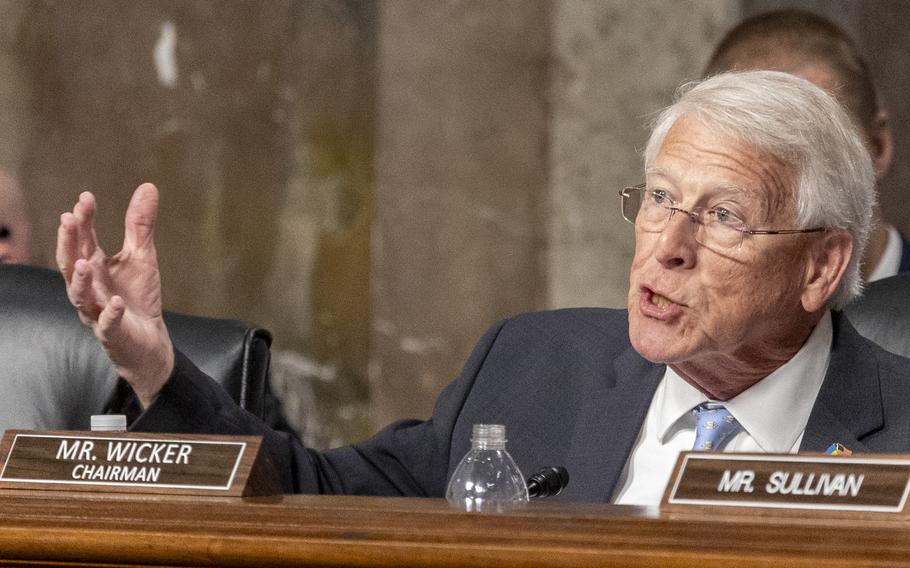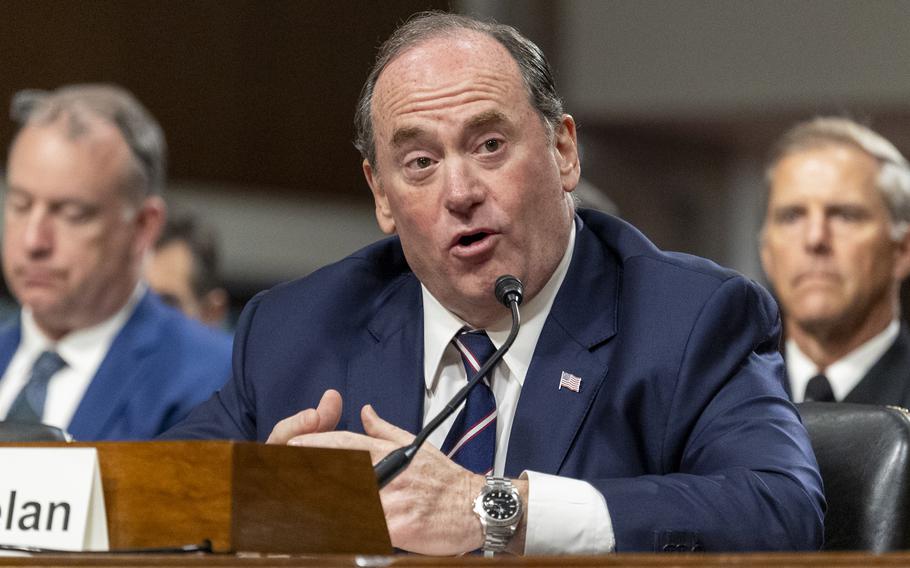
Sen. Roger Wicker, R-Miss., chairman of the Senate Armed Services Committee, speaks in March 2025 at a committee hearing. (Eric Kayne/Stars and Stripes)
WASHINGTON — The Navy is proposing a $16 billion cut to shipbuilding in 2026 and does not intend to move forward with plans to purchase at least six new warships, the top Republican on the Senate Armed Services Committee said Tuesday.
“I am deeply disappointed with the administration’s fiscal year 2026 budget request for the Navy. Particularly I am disturbed about the shipbuilding account, which plummeted to $20.8 billion from last year’s $37 billion,” Sen. Roger Wicker, R-Miss., chairman of the committee, said during a hearing on the Navy’s budget.
The Navy’s 2026 budget, which has yet to be provided in full to Congress, is poised to undercut efforts to restore shipbuilding, Wicker said.
The Navy does not intend to ask for two new destroyers in its 2026 budget, which the sea service has historically purchased each year. Instead, Wicker said the service seems to be counting on additional funds from a separate bill under consideration now in Congress that would provide the Pentagon about $150 billion to invest in shipbuilding, a layered missile defense shield and other defense priorities. Republicans are pushing that bill through Congress using the reconciliation process, which will allow them to bypass Democratic opposition and pass the legislation with a simple majority vote.
“This shortfall reflects efforts to game the budget in anticipation of congressional reconciliation funds, which were intended as supplemental — not a substitute,” Wicker said.
The Navy’s proposed budget also does not include the purchase of new Virginia-class submarines, two of which the Navy typically has sought to buy each year, the senator also said. The submarine class was among several shipbuilding programs identified in 2024 by then-Navy Secretary Carlos Del Toro for falling behind schedule. The Virginia-class submarines are running 24-36 months late.
Nor will the service seek to purchase two Constellation-class frigates, a troubled shipbuilding program that was halted as the service and the shipbuilder try to figure out how to build the ship. The Navy began work on the first Constellation frigate in 2022 with a then-estimated price tag of $1.3 billion. But estimates have since ballooned by more than $200 million, and delivery of the ship has been delayed by three years to 2029, according to the Government Accountability Office, a federal watchdog.
The committee, Wicker said, expects a clear plan to restore shipbuilding momentum, and he expressed congressional commitment to work through the Navy’s shortfalls. But before that can happen, the Navy must deliver its budget in full to Congress.
“An announcement from the Navy will need to be made soon, Mr. Secretary, or we will risk further challenges to the industrial base,” Wicker said, directly addressing Navy Secretary John Phelan.

Navy Secretary John Phelan testifies Tuesday, June 10, 2025, during a Senate Armed Services Committee hearing on the Navy budget. (Eric Kayne/Stars and Stripes)
The Navy, which relies on contracted private shipbuilding companies, has come under fire in recent years for its shipbuilding struggles. The sea service planned to have a battle force of 313 ships by 2025. But in its fiscal 2025 shipbuilding plan, the Navy said it will have 287 ships by 2025 — 26 fewer ships than expected. Meanwhile, China, considered America’s top military competitor, is rapidly growing its fleet and is on pace to reach a 425-ship fleet by 2030.
Phelan, who testified before the senators Tuesday, has said strengthening shipbuilding is his No. 1 priority. But Sen. Angus King, I-Maine, said the Navy’s proposed base budget contradicts Phelan.
“All the talk about building up ships and then having shipbuilding cut in half doesn’t jive,” King said.
Phelan said in his opening remarks that he now has a “clear picture” of the Navy’s challenges and is developing a plan “to fix what is broken.” He said he recently toured three foreign shipyards and seven domestic shipyards to learn what could be done more efficiently. Additionally, Phelan said he is working closely with the Pentagon and the White House Office of Management and Budget and said the efforts were moving in “a good direction.”
“I hope so. As a wise old New Englander once said, your actions speak so loudly I can’t hear your words,” King said.